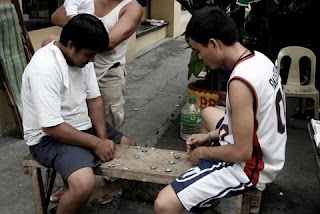
A panaderia in Malate with sugary, margarine-y sweet things.
I am half-glad I lost the taste for Filipino baked wheat goodiess circa my pre-teen years, otherwise I would be twice my size with profound and expensive dental problems. The ubiquitous bakeries or panaderias punctuate both urban and rural areas, with empty calories and hints of margarine, red and purple food coloring, and lots of sugar.

This is not to say I don't find the panaderias charming. I still routinely ask whether they have anything (at all) that doesn't have margarine (answer is always no), and once in awhile stop to watch the breadmaking process. I yearn for the two-peso star bread of my youth, whose angular, crunchy, sugar-sprinkled crown I devoured like I do muffin tops, whilst walking around the village, tossing the homogenous, boring bottom in the direction of stray dogs.

A Quezon panaderia with sweet breads, filled pan de sal, and loads of star bread (bottom right).
Nowadays, making my way home at ungodly hours, the 4 AM smell of baking bread makes me appreciate how we still have dedicated artisans who wake before the cocks crow (or during-- the city lights make ours noisy as early as 2AM). Their incessant kneading supposedly breeds local boxers (e.g. Manny Pacquaio and his once-floured fists). A few are legendary in less agreeable (yet equally sensational) ways-- I've heard horror stories of panaderos wrapping ensaimada around their private parts or rubbing pan de sal in their armpits.
But where did these originate, these creations with ingredients so foreign to our native agriculture? Last year, a walk to a (Chinese-run) Mexican grocery store in California revealed a large clue: unabashedly sweet, swirly, and colored breads. In fact:

In California: Mexican pan dulce, with some cajeta or milk caramel empanadas on the left.
While pan de sal is one specific, ultra-popular bread to Filipinos, in Mexico, the term (which literally translates to "bread of salt") refers to a number of non-sweet, mealtime-appropriate breads, to be eaten with savory and salty food. In fact, it has been said that our Filipino pan de sal bears resemblance to one kind of Mexican pan de sal.

More Mexican pan dulce.
Pan dulce, on the other hand, is a sweeping term again, pertaining to any or all kinds of Mexican sweet breads. Like the Philippines, they have many, in different shapes and colors. In both Galleon countries, they are eaten at all times of day, especially at merienda-- and, on both sides of the ocean, each costs not more than a few pesos.
Baking bread in the Philippines (as we know it) definitely developed during the Spanish occupation. In Mexico scholars suppose it was either them or the French. But how did both colonies develop these large, down-to-earth, un-fussy versions, so different from their European ancestors? Only more investigation can tell. In the meantime, take the time out to actually stop at your local panaderia and ponder its existence.





































